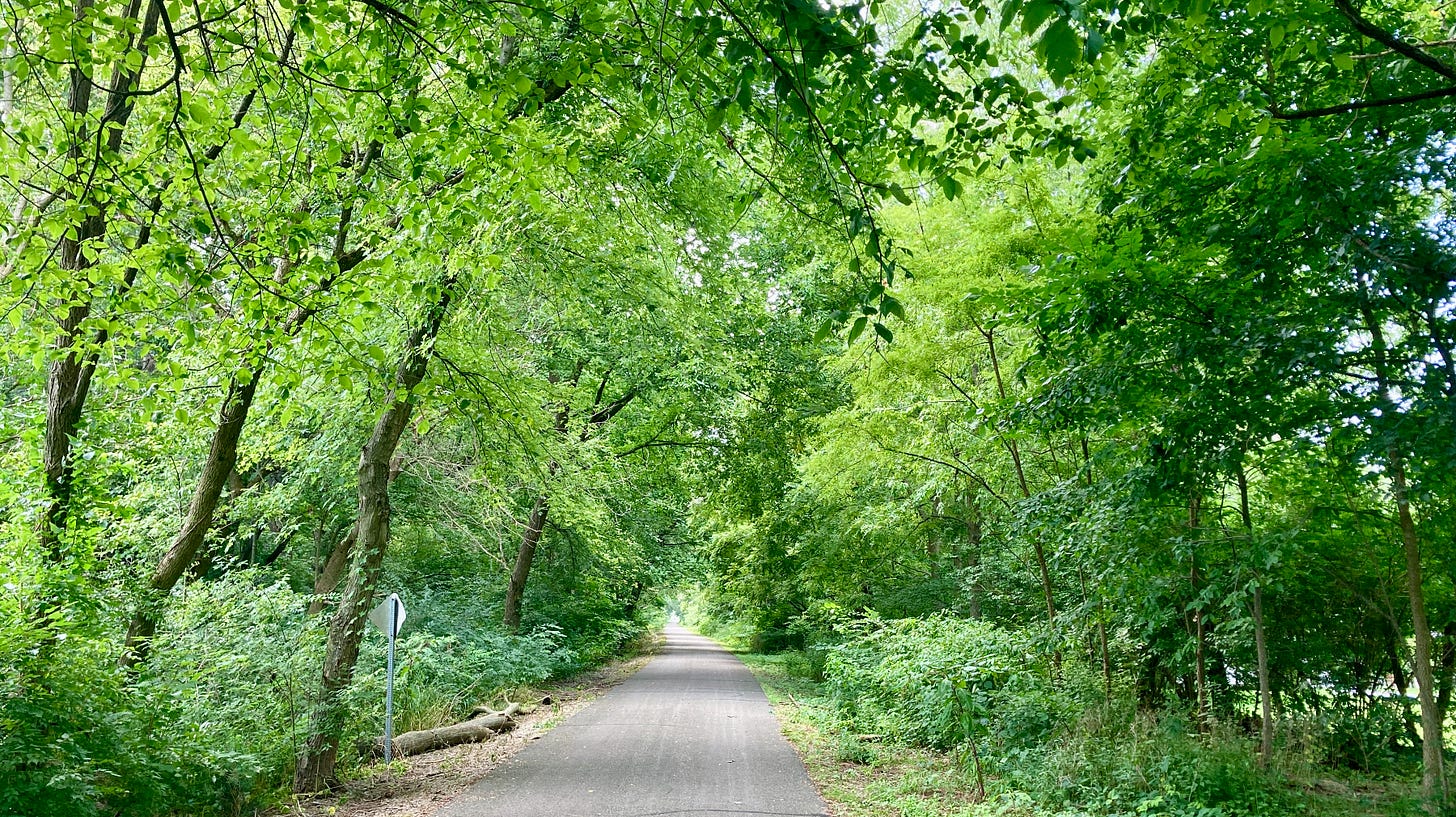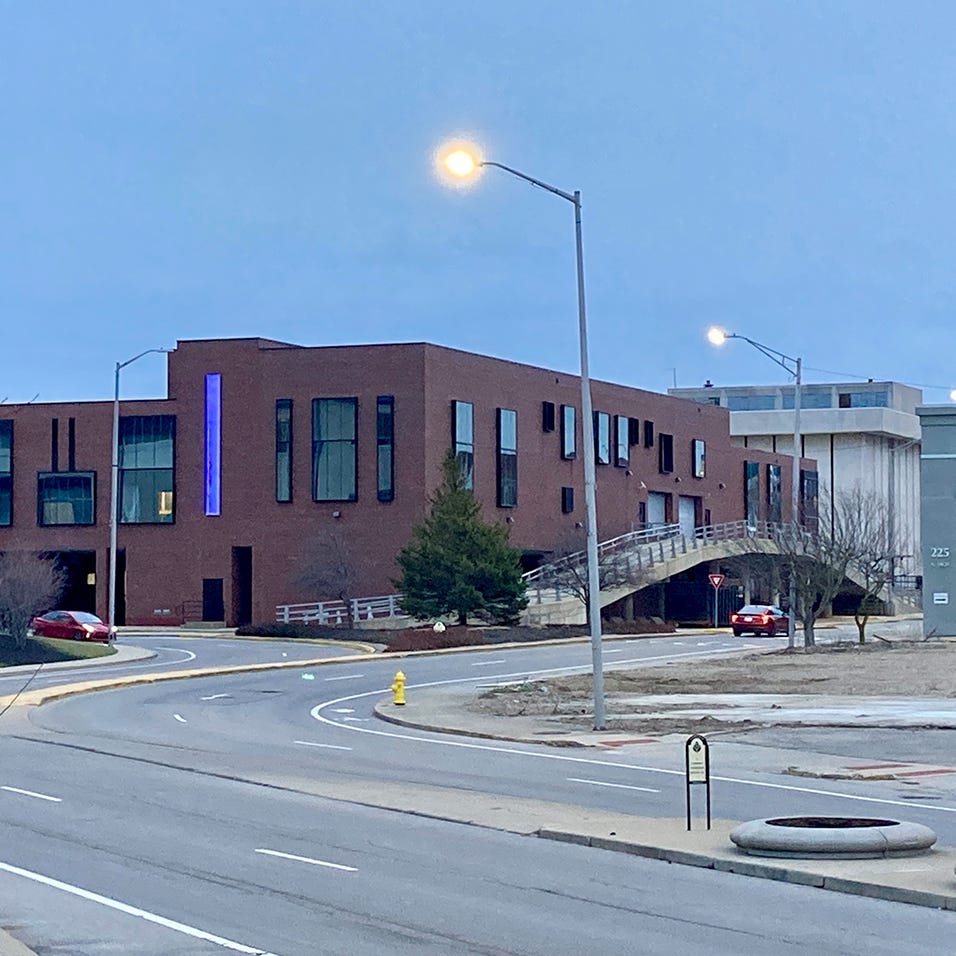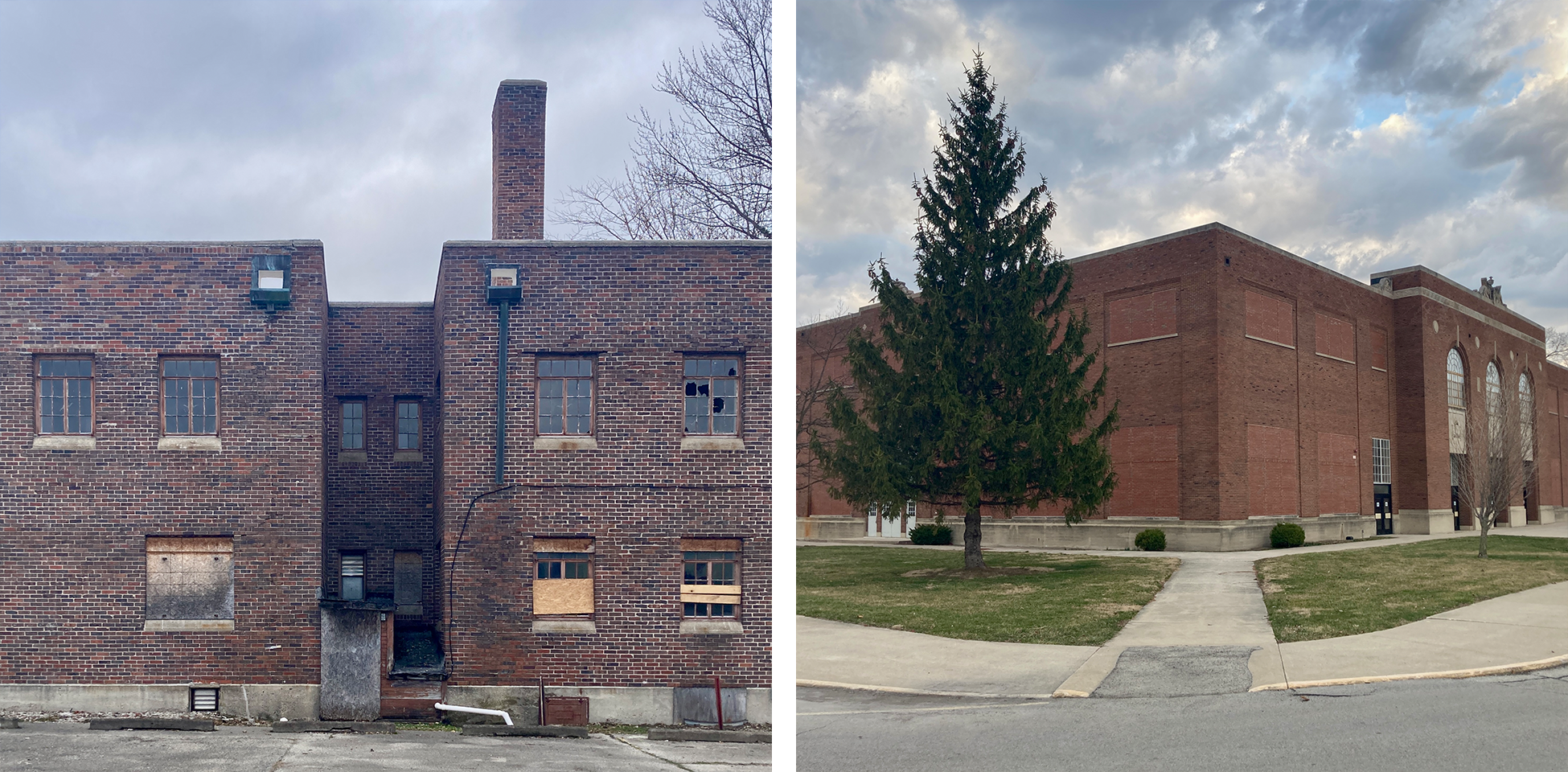
One of the recurring themes of these Muncie photo digests (see below for past installments) is me walking around in neighborhoods full of abandoned buildings, where I don’t encounter very many people. My route usually takes me along the White River Greenway, a pedestrian and bicycle path that cuts through our East Central Indiana Rust Belt town before rejoining the Cardinal Greenway, a rail trail and the longest continuous bike path in Indiana. It’s pretty much the only place I go walking, and to be fair many of my outings are not at peak hours for foot traffic. But even on these first 70ºF afternoons of the year, I rarely pass by more than three or four people while logging as many miles.
Of the places I’ve lived as an adult, it was ironically the sprawling metropolis of Los Angeles where I had the most access to wild spaces, whether it was the crowded trails of Griffith Park or the quiet paths of the San Gabriel Mountains. Marfa, Texas was surrounded by high desert grasslands, but it was mostly private land and people in Texas have a lot of guns. I also lived briefly in the early ‘00s in a cabin in the Santa Cruz Mountains, but that was a sinister time characterized by a paranoid malignancy specific to the redwoods that still gives me the creeps 20 years later.
Solitude on these Muncie trails is often a pleasant experience, even if the pleasure is in the quiet melancholy suggested by Spouse Rachel’s observation that her hometown feels like “a place where something happened once, came to an end, and may never happen again.” It’s an apt description of the Rust Belt, and the fallout from economic policies that encouraged the manufacturing sector to outsource regional living-wage jobs to places where the living wage is much lower. Or more likely, to places where people are too desperate and oppressed to demand a living wage from their bosses. This was the Steel Belt once because humans made steel here for decent money: it’s the Rust Belt now because the atmosphere’s moisture corrodes abandoned steel into rust, for free. I’ve worked in food service, at a call center, at a catering company, on a landscaping crew, and as a trauma janitor 911 medic, but I’ve never worked a factory job: For me this is an imaginary utopian blue collar history represented only by its industrial ruins, and to a lesser extent, the various decrepit and renovated Victorian mansions scattered through downtown residential areas.
Deindustrialization and re-wilding sound like good things. But as with the elimination of human jobs and the rapacious appropriation of any cultural product not protected by vigorous IP lawyers from the cultural drift nets we refer to as artificial intelligence, such words must be examined with an eye on who is speaking them. The vintage futurist perspective on “the end of work” suggested a more leisurely existence for humans as menial labor was outsourced to machines. Under our current economic system, allowing humans to have more time to develop friendships, maintain creative practices, care for loved ones, or to simply indulge in the profound pleasure of intentional idleness is sacrilege. Or as they say online, “In the 1960s futurists predicted robots would take over menial labor so humans could have more time for making art and connecting with each other. In 2024 our tech overlords are developing robots that can create art so humans are forced to perform menial labor for longer hours and less compensation.”
As a person descended from the extremely annoying white supremacist Puritan devils who started the process of transforming North America into an industrial wasteland through genocide and the conviction that labor – regardless of its destructiveness or inconsequentialness – is a moral good, I renew my commitment to proselytizing on the merits of laziness. Continuing to build on the theme of the inaugural Muncie Photo Digest in August 2021, as expressed by Alan Watts in Nature, Man and Woman (1958):
"a certain amount of ordinary laziness would lend our culture the pleasant mellowness which it singularly lacks”
Liquid Advertisement and Gaseous Desire
The images in this Muncie Photo Digest are from 2023-2024, a collection of images that I wasn’t sure how to group together until the other day when I was walking around listening to the Michigan-based artist Magdalene’s February 2024 album ショッピングモール. The album’s title is translated from the Japanese as Shopping Mall. “I've been a bit obsessed with mallsoft lately,” they write, “so I figured I'd make a tribute to my childhood mall where I had my first job at a CD shop.”
Mallsoft is a subset of vaporwave, a genre of ambient electronic music that became widely known in the 2010s, and is steeped in meta-nostalgia for the ‘90s. Meta-nostalgia because it is primarily made by people who were either very small during, or not yet born in the ‘90s. It’s described by its own community as “music optimized for abandoned malls.” Mallsoft aka mallwave is like still-strength, over-proofed vaporwave, the strongest possible concentration of the genre’s slowed and throwed bricolage of escalator muzak, Quiet Storm instrumentals, food court field recordings, and mass-produced digi-jazz. “Global capitalism is nearly there,” the moderators at r/Vaporwave write. “At the end of the world there will only be liquid advertisement and gaseous desire.”
Even more so than vaporwave’s gloriously countrified variations (e.g. tumblewave1), colorfully mushy manifestations (e.g. slushwave), or dystopian brand-specific schools of thought (e.g. Tupperwave), mallsoft offers some of the dankest of known huffable fumes. In keeping with the ‘90s nostalgia, its aesthetic is aggressively postmodern and plunderphonic. “This is a mixtape of slowed, chopped, and screwed music from royalty-free sites,” Magadalene writes of ショッピングモール. “I take credit for the vibe, not the music,” they continue, further distancing themselves from concepts like originality or authenticity. The vibe, while mostly pleasant, also has an air of sadness, a saccharine aftertaste familiar from the saxophone melancholy of slow-motion love scenes from ‘90s Hong Kong action movies, or the addictive sentimentality that characterizes high lonesome hold music earworms like “Opus Number 1.”
Vaporwave artists’ disillusionment with capitalism – simultaneously world-weary and youthfully naive – is manifested in vast catalogs of music that is often cheap, if not free, in digital format, with physical media reserved for the most auspicious of albums. For example, one can download almost all of the 31 releases from perfectly-named vaporwave hero desert sand feels warm at night individually for however much you want to pay. Or cop the entire catalog at once for £1. Not coincidentally, the philosophical term “hauntology” that is often applied to vaporwave was first coined by Jacques Derrida in a series of lectures on the future of Marxism, as assembled in the 1993 collection Specters of Marx: The State of the Debt, the Work of Mourning and the New International.
If one opens up exploration into the adjacent aesthetic2 of hypnogagic pop or hauntology writ large, the vaporwave ecosystem expands into a digital infinity that ranges from superstars like Oneohtrix Point Never aka Daniel Lopatin, who has gone on from formative genre classics like 2009’s Zones Without People to soundtracking A24 projects; to acclaimed artists like James Leyland Kirby who represents dementia with loops of decayed big band vinyl; to disgraced pop stars like Ariel Pink who turned their simulated nostalgia to edgelord provocations; and finally to anonymous Bandcamp pages and international vaporwave message boards.
It’s this legion of relative unknowns who further complicate their identities by switching between English and various Asian languages in their artist profiles and liner notes in a way that could be interpreted as respectful, aspirational, or fetishistic. As the generational baton is passed, the focus moves from the dead malls of North America to a “relaxing rainy cyberpunk noodle bar ambience” that is just as likely driven by enthusiasm for the contemporary street food of Shanghai as nostalgia for the cuisine of ‘90s Los Angeles from the Blade Runner timeline.
Zones Without People
But this newsletter isn’t even about Muncie’s own dying mall. It’s supposedly about photos from walking around the empty greenways that cut through the decaying post-industrial architecture of the East Central Indiana Rust Belt. And we haven’t even gotten to the Heart Sutra reference from the title either:
Shariputra, form does not differ from emptiness, emptiness does not differ from form. That which is form is emptiness, that which is emptiness form. The same is true of feelings, perceptions, impulses, consciousness. Shariputra, all dharmas are marked with emptiness; they do not appear or disappear, are not tainted or pure, do not increase or decrease.
The Heart Sutra is one of the most popular sutras in Mahayana Buddhism. Also known as The Maha Prajna Paramita Hrdaya Sutra, it’s cited in the Encyclopedia of Buddhism as "the single most commonly recited, copied, and studied scripture in East Asian Buddhism." It was the sutra we chanted at each meditation practice when I lived at the Indianapolis Zen Center – visit kwanumzen.org for one translation – and is one of the most compact, if not immediately digestible, summations of Zen thought.
The Heart Sutra is a brief, chanted dialogue between the bodhisattva Avalokiteśvara and a disciple of the Buddha named Shariputra. In classic Zen style, it goes back and forth between convoluted or contradictory statements: “no attainment with nothing to attain,” but also “all Buddhas depend on Prajna Paramita / and attain Anuttara Samyak Sambodhi.”
Lifetimes have been spent parsing the meaning of the sutras, and I am a lazy student of Zen at no risk of attaining the title of dharma teacher or religious scholar. But sutras are poetry, and while a technical understanding of poetry is a worthy thing, you don’t need an intimate knowledge of iambic pentameter to feel a verse. In this case, the language fits with our discussion of the seemingly abandoned public spaces and industrial ruins where I spend time imagining what Muncie once was, as well as the sincere yet expressly synthetic nostalgia that vaporwave artists have for a time they never experienced.
If the present moment is all that exists ( . . . now . . . now . . . now . . . ) then the authenticity of nostalgia can become moot, at least emotionally or spiritually. Neither the real nor the imaginary past exists other than as a thought. In these cases it is discerned through my own ignorant interpretation of dead architecture and the emotional response vaporwave musicians express for the simulated ruins of postmodern consumerist architecture: All dharmas are marked with emptiness; they do not appear or disappear.
I’ll wrap up this intro by saying that along with Kirby and the cohort of post-millennials on Bandcamp like New Mexican Stargazers and A Name For Both of Us, I find the work of James Ferraro (Lamborghini Crystal, Acid Eagle, Newage Panther Mistique) and Spencer Clark (Vodka Soap, Typhonian Highlife, Fourth World Magazine) holds up best after a decade or so of repeat listening. They started out as weirdo noise dudes making fractured psychedelic clatter as The Skaters. Ferraro has gone on to collage and rebuild the imaginary devotional sounds of the Scientology and Heaven’s Gate cults, and has since spun out into unpredictably damaged art-pop music under his own name. As Monopoly Child Star Searchers, Clark makes a kind of deconstructed fourth world ambience that occasionally flirts with tiki vibes (uh oh) but ends up sounding like Jacques Cousteau’s lost field recordings from John C. Lilly’s DMT-fueled dolphin raves (oooh yeeeah).
Keep scrolling for the actual photographs! And keep it locked on Vøid Contemplation Tactics and Inter-Dimensional Music on WQRT Indianapolis and Marfa Public Radio in Far West Texas for a soon-coming extremely non-definitive mix of the handful of vaporwave artists I’m passingly familiar with. Thank you once again and as always for reading the words, clicking on the pictures, saying nice things in the comments, subscribing, lurking, sharing, or moving on down the line if rambling essays about the intersection of Zen aphorisms, the synthetic nostalgia of post-capitalist electronica, and amateur architectural photography are no longer of interest.
blessing up and blessing down,
Daniel
There are few more sinister attempts to erase histories in Muncie than the new downtown loft/AirBnB complex that was until very recently the Muncie jail. The renovated structure is adorned with a lighted . . . uh . . . narrow . . . uh . . . cerulean? . . . stripe. A not terribly subtle wink to the building’s history as a cop nest. The womens’ wing has been transformed into the ultimate party lockup where carcerally-minded revelers can sleep in retrofitted cells and splash about in a massive second-story hot tub where soakers will enjoy the view of our dirtbag pals blowing clouds of cigarette smoke from the porch of beloved local pub Savage’s.
I pass by Bad Boys Bail Bonds and this extremely low key spa (?) on almost every walk. I have never seen anyone inside or even thinking about going inside either one, but the lights are often on.
The building on the left is the abandoned Planned Parenthood building and the building on the right is the not abandoned Muncie Central Fieldhouse that first opened for basketball in 1928.
Brutalist and proto-brutalist architecture on Jackson Street.
One of the many massive oxidizing industrial structures near the Craddock Wetlands Preserve.
Sandi Corporation RV, Camper, and Boat Storage (L) is open, while it appears that the Spiritual Missionary Baptist Church (R) is not.
A new generation of abandoned architecture emerges. The Midland Business Center is “temporarily closed” according to Google Maps. It may not be on track to return though, given its mediocre three star-rating. “Sucks,” Local Guide Bekka Beki wrote seven years ago to accompany her one-star review. Local Guide Doc*Savage disagrees: “Deliver the load thay got me In-N-Out,” he writes, offering cryptic context to his five-star rating, not only because the nearest In-N-Out Burger is over a thousand miles away.
I don’t know how cryptocurrency and web point three dot com is doing in your town, but here in the Rust Belt it’s been a success in freeing our impoverished population from the tyranny of the same (((banking regulations))) that many racist oligarchs are worried about. Crypto is such a hit in fact that local freedom-loving entrepreneurs are advertising their trustworthy crypto schemes by pasting flyers to derelict ice machines at the Marathon station downtown that has the biggest selection of off-brand but still technically legal gas station drugs. “Ice bags are inside” and also shout out to Free Larry from Atlanta.
BONUS: Two graffiti stragglers from the previous End to End Burners street art edition of our photo digest: “Me and Mrs. Toots got a thing going on” (L) and a juicy backstreet sigil (R).
If you know anyone who might find value or otherwise enjoy Vøid Contemplation Tactics or Inter-Dimensional Music, please pass it along. It means a lot to me! Thank you. If you’d like to support these projects with a one-time donation, you can also drop some ducats in the tip jar.
Previous photo digests from Vøid Contemplation Tactics . . .
Pleasant Mellowness
Muncie remains an easygoing place to weather the ongoing Covid-19 pandemic. Choose the right route at the right time of day and a long walk can be an almost entirely solitary experience. These photos aren't intended as poverty porn or purely as Eggleston-worship, but an appreciation of the corners of the built-up areas that have cracked and eroded after extended periods of disuse. Alan Watts wrote in
End to End Burners
We’re freshly returned to the denuded low-rolling prairie of the East Central Indiana Rust Belt, and are marking the occasion with another semi-quarterly Muncie Appreciation Photo Digest. Re-entry can be difficult here, especially if I’m coming back from a beautiful wilderness-ish place such as the
Not to be confused with the dreamy guitar-heavy country genre known as “bootgaze.”
These are just a few audio entry points to the pre-fabricated imaginary nostalgia that falls under the vaporwave label. For me, an early encounter with this world came at its peak in the ‘10s through the network of tumblrs – many now disappeared without a trace – organized by artist and curator Kai (Kari) Altmann. Images optimized for abandoned malls, archived on the abandoned web.
Altmann’s r-u-ins.link site is still transmitting, overflowing with images of occult technology, weirdly textured silicon/organic objects, and re/de-contextualized photography of interesting people doing strange things around the world. Not technically vaporwave music, but this cohort’s work shares enough of the philosophical and aesthetic vibe to be considered vaporwave album covers.




















This piece made me cry. Rachel's (an old friend and Burris peer) description of Muncie is the very best one I have heard. It is exactly the way I feel about my hometown. Such sadness and such joy. It sanded my edges exactly where they needed to be and gave me all I needed. The way you described the steel belt and now the rust belt.....I can feel the Muncie air through your words. You are a fantastic writer...thank you for sharing pieces of Muncie with me through here.
Could you offer a tour of the Muncie greenways? How many are there? I could envision a 3-day eCycle tour with evenings of psychedelic-enhanced void contemplation. Could you pull it together for $500.00 per person?